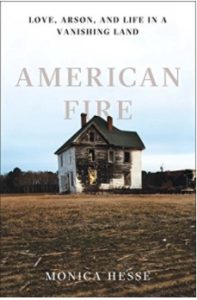American Fire
A few months ago, my friend Kenneth suggested I check out Book of the Month and I chose American Fire as one of my selections.
On the surface, American Fire is an exploration of who set nearly eighty fires in Accomack Country, Virginia in 2012 and 2013. But it is so much more than that, too. It’s an examination of rural America. Accomack used to be one of the wealthiest counties in the United States. Now, like so many other rural counties, it is more desolate as fortunes have shifted.
But there’s even more to the story, and that is the story of the arsonists, Charlie Smith and his girlfriend, Tonya Bundick.
American Fire is somewhat slow paced, and didn’t have me turning pages at a frenetic pace, but it did keep me interested. The sheer number of organizations involved in not only fighting the fires, but also trying to find the arsonist(s), is mind boggling. We get insight into the approach of the law enforcement agencies, the profiles they put together. The nearly overwhelming exhaustion of multiple volunteer fire departments fighting fires night after night. The home grown arson-finders.
And then, what is possibly the most interesting part. The motivations of Smith and Bundrick. How did they go from madly in love to setting 86 fires? And once you’re in an interrogation room, how far does that love go?
Monica Hesse began following this story for the Washington Post, and what she saw there sparked an interest in her that became American Fire. The writing is straightforward and clear. She includes first hand accounts where possible. Without being dramatic, you feel the frustration of the first responders.
I don’t remember hearing about this case when it happened, although as I’ve done some googling, it was written up in the Washington Post, among other places. I found the book to be fascinating, although as I said, a bit slow paced. Still, this is one I recommend if for nothing more than its glimpse into the human psyche.
- 0 Comments
- Tags: Arsons, Charlie Smith, Monica Hesse, non-fiction, Virginia
The Boyfriend Swap
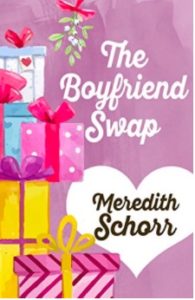
Reading The Boyfriend Swap is like watching an entertaining chick flick unfold on the page rather than screen. It has the feel of two of my favorite Holiday films, Love, Actually, and The Holiday.
By natured of its premise, you have an idea where the story is going to go, and its a fun ride getting there.
Schorr’s trademark, for me, is relatable characters, and she doesn’t disappoint here. Robyn is the kind of person I would want to be friends with. And Sydney would exasperate me sometimes. Honestly, at first glance, she’s not terribly likable, but she grew on me. But, what made this book enjoyable is the chemistry that practically radiated off the page between a certain character and… well, I won’t give anything away here. You have to read this one for yourself.
While this is chick-lit, Schorr is not formulaic. Things happen that you expect, but a lot will surprise you, too. And I think it will make you smile. That’s something we all need more of.
The Boyfriend Swap will be released November 7. It’s going to be the perfect escape from reality and get you in the mood for the Holidays. Put this one on your to-read list!
What Made Maddy Run
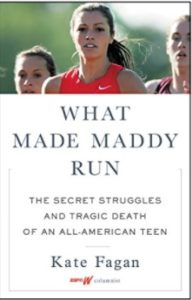 Kate Fagan’s What Made Maddy Run is a heartbreaking, yet essential read.
Kate Fagan’s What Made Maddy Run is a heartbreaking, yet essential read.
“In interviews with Madison (Maddy) Holleran’s family and friends, and exhaustive reading of her texts, instant messages, and emails, Fagan reconstructs Maddy’s descent into mental illness that ultimately led to the elite athlete’s suicide at the University of Pennsylvania.
What emerges is a haunting recounting of a mental illness that probably had roots long before Maddy’s days in track at the University of Pennsylvania, but manifested itself there with the transition from high school elite athlete to a competitive college athletics program.”
I remember dreaming of college and what I thought it would be like. I remember the transition being challenging in some ways- this only child had to learn to effectively share with other people and give up privacy- but it seems to be harder now than it was then. And it can be even more difficult for athletes or other elites, who were standouts in their high school world but just one of many in the college network. Additionally, this generation has always been digital. Their whole lives are instagrammed or facebooked or snap-chatted in ways that show only the best. Filtered to show them in the best light. They text with their parents constantly, and are receiving immediate feedback on everything in the form of likes. Somewhere in the mix of it all, the transition to college is that much harder.
When a student also suffers from mental illness, the challenges of transition are only exacerbated. What makes What Made Maddy Run so heartbreaking is that no one was in denial that Maddy was in trouble. Her parents were deeply concerned. Parents of her friends noticed things. Maddy was seeing and finding a new therapist. She had a plan in place to get her through the semester at Penn when she could then look at other options for schools. She seemed to be hanging on….until.
Fagan recounts Maddy’s story with sensitivity and unexpected insight. She shares text conversations between herself and others with insight into depression. She’s compassionate and respectful of both Maddy and her family. Maddy’s story is heartbreaking because it is so relatable. And sadly, not so uncommon. Many college and university coaching staffs and health facilities are not equipped to effectively deal with mental illness. By telling Maddy’s story, Fagan helps bring awareness to this issue.
And Fagan reminds us that what we see on the surface isn’t always what’s going on with someone. A good reminder for us to be a little kinder to each other.
Although this one doesn’t have a happy ending, I consider it essential reading.
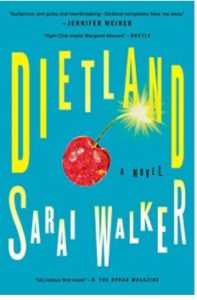 Stop what you are doing and get a copy of Dietland now.
Stop what you are doing and get a copy of Dietland now.
It’s been a while since I read a book in one sitting, but that’s how much I enjoyed Dietland. I described it to a friend as “truth, humor, and a revenge chick-flick all in one.”
From the publsiher’s summary:
The diet revolution is here. And it’s armed.
Plum Kettle does her best not to be noticed, because when you’re fat, to be noticed is to be judged. With her job answering fan mail for a teen magazine, she is biding her time until her weight-loss surgery. But when a mysterious woman in colorful tights and combat boots begins following her, Plum falls down a rabbit hole into the world of Calliope House — an underground community of women who reject society’s rules — and is forced to confront the real costs of becoming “beautiful.” At the same time, a guerilla group begins terrorizing a world that mistreats women, and Plum becomes entangled in a sinister plot. The consequences are explosive.
“A giddy revenge fantasy that will shake up your thinking and burrow under your skin” (Entertainment Weekly), Dietland takes on the beauty industry, gender inequality, and our weight-loss obsession — with fists flying.
I’ve been gushing about this book, telling everyone I know to read it, and finding a way to do it without giving away anything is a challenge. Parts of the book made me terribly uncomfortable- exactly Walker’s plan, I suspect. Things that inundate us in our psyche every day, and should outrage us but don’t. While it’s a fun read, the book also makes you think- or should. How we treat people, how we choose our insults, how we measure an individual’s worth. We walk around in Plum’s skin a bit. Her journey could be our journey. Now’s actually the perfect time for Dietland. If you’ve paid any attention to the news of harassment in the last week or so, you’ll see why Dietland matters.
Walker takes on some challenging issues in this book- but does it in a non-preachy, empowering, and sometimes cringe-worthy way. i
So I don’t spoil anything, I’ll stop with this: If you’ve been angered by Harvey Winestein, “Grab them by the Pussy”, the endless “me, too” posts highlighting a very real problem, then READ THIS BOOK. NOW.
Don’t Date Baptists And Other Warnings From My Alabama Mother- an Author Interview with Terry Barr
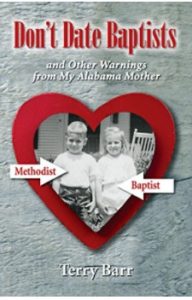 I read Don’t Date Baptists earlier this summer and it made me laugh and cry.
I read Don’t Date Baptists earlier this summer and it made me laugh and cry.
I know Terry Barr personally- he is a professor at my alma mater. As such I felt like it would be best that I not formally review the book. But I did really enjoy it, and I want to help get the word out about it. Terry was gracious enough to agree to an author interview. Enjoy.
You can get your own copy of the book here.
TBF: At first, Don’t Date Baptists appears as if it’s going to be funny, full of anecdotes about life in a small southern town. But you definitely go deeper than that. How did you find the right balance between humor and showing the underbelly of “polite society”?
I think the main thing I did, or tried to do, is to keep in mind that most of the people I knew and have written about were basically, intrinsically, good people. I know that sometimes they were harsh, and sometimes so was I in writing about them. I know that I have hard feelings about people I knew “back then,” but I also know that some of these same people nurtured me, spent much time with me, and shared with me our lives. They could be warm and funny and southern sweet, like most of us can. I didn’t have to “humanize” anyone; I simply tried to remember the very real sides to their complex characters. I tried to be authentic as far as I could remember and to the best of my memory. It helps, too, to remember that we are all products of our times: our era, our families, our peers. What if my parents had supported George Wallace? Again, sometimes I am too hard on people, but I do try, at least, to see their good sides and their humor.
TBF: I’ve never lived in a small southern town, but both my parents grew up in one, so they’ve always been a part of the fabric of my life. Do you think life in these towns is idealized?
Yes I do. Not by me so much, but I hear people say that the time and place we lived in was idyllic. Well, no, it wasn’t, though I had a great life. For instance, when you try to cram 1600 students into a school meant for 800, when that school was originally built for white people to escape zoning and integration, and when in that school you never knew who might get knifed or threatened, well, no, I don’t consider that in the golden haze of the homespun southern charm of idealized small town life. Still, I could walk to our downtown by myself or with friends. One of my friends had his own charge account at our neighborhood grocery. I got a lot of free Reese’s cups and football cards through him. We went into each other’s houses all the time and our mothers carted us around everywhere. I’m speaking of all my friends now. In Bessemer, as in other small towns, there was also great poverty and it was clear for everyone to see. Even within our friend groups there was division along class lines. It both was and wasn’t Mayberry, but I don’t remember any Andy Griffith figures who watched out over all of us.
TBF: I told you when I was reading the book that a couple of parts made me cry. Specifically a couple of stories involving race. I found them especially poignant in our current political environment. Do you have any other thoughts you want to express about it? Or hindsight views in how what you wrote is potentially even more relevant now?
I hope these are relevant stories because what sort of society are we living in today? At PC, our opening convocation speaker this year said we are living in a “Post-Post Racial society.” We haven’t gotten past the hostilities of race, even though we know more people of other races today as friends, colleagues, and neighbors. I say neighbors, but consider: in my mother’s Lakewood neighborhood back in Bessemer, the racial makeup is probably 70-30 Black to White. She and her next door neighbor, who is Black, get on quite well. But does the neighborhood have gatherings? Is it cohesive?
Now my neighborhood in Greenville has an association that sponsors picnics, holiday open houses, and a crime watch. But there is only one mixed race family in the entire neighborhood.
At PC, we now employ 3 African-American professors. When I started back in 1987, we had just hired the first African-American professor ever. In the school cafeteria, you still see much segregated seating. We all notice, but what sort of impact do these things make on us?
TBF: Would you like to talk a bit about your writing process?
I try to write 3-4 times a week while I’m in the semester. I write in the mornings mainly, after I’ve read something nonfiction oriented, after I’ve had several cups of coffee (I order from red Rooster coffee in Floyd, VA), and after I’ve walked Max, my Carolina dog. I try to write for a couple of hours, but am happy if I get one hour. Sometimes it’s just random thoughts, but mainly I write with a certain memory or experience at the core. A few nights ago, we say Keb Mo and Taj Mahal at the Peace center, and while I was enjoying their electric blues, an image from my past announced itself and I had to do everything in my power to wait until the next morning to write.
TBF: I know you read a lot of essays from places like The Bitter Southerner, which I love and help support financially. Why TBS? And what other sites do you read regularly?
I love Full Grown People, Creative Nonfiction, Oxford American—must reads!!!
TBF: What’s in your to-read pile currently?
I am just finishing Newspaper Wars by Sid Bedingield, about South Carolina’s press, white and black, during the pre and full civil rights era. Next is Douglas Blackmon’s Slavery By Another Name. For fiction, I just finished Tom Perotta’s Mrs. Fletcher, I am in the middle of Celeste Ng’s new one, Little Fires Everywhere, and am looking forward to Jennifer Egan’s Manhattan Beach and Thomas Mullen’s Lightning Men.
TBF: What’s been your favorite thing about publishing a book? What’s the most unexpected thing about it, good or bad?
Having book signing parties!!! The most wonderful and unexpected thing was to reunite with old friends who found me again through the book.
TBF: What advice would you give to someone considering writing non-fiction, about their experiences?
To write all the memories you can first, and then get honest about how well and accurately you remember these events. I hope you have a brother and a trusted group of old friends, as I do, who can test your memory with theirs and help you check yourself!
